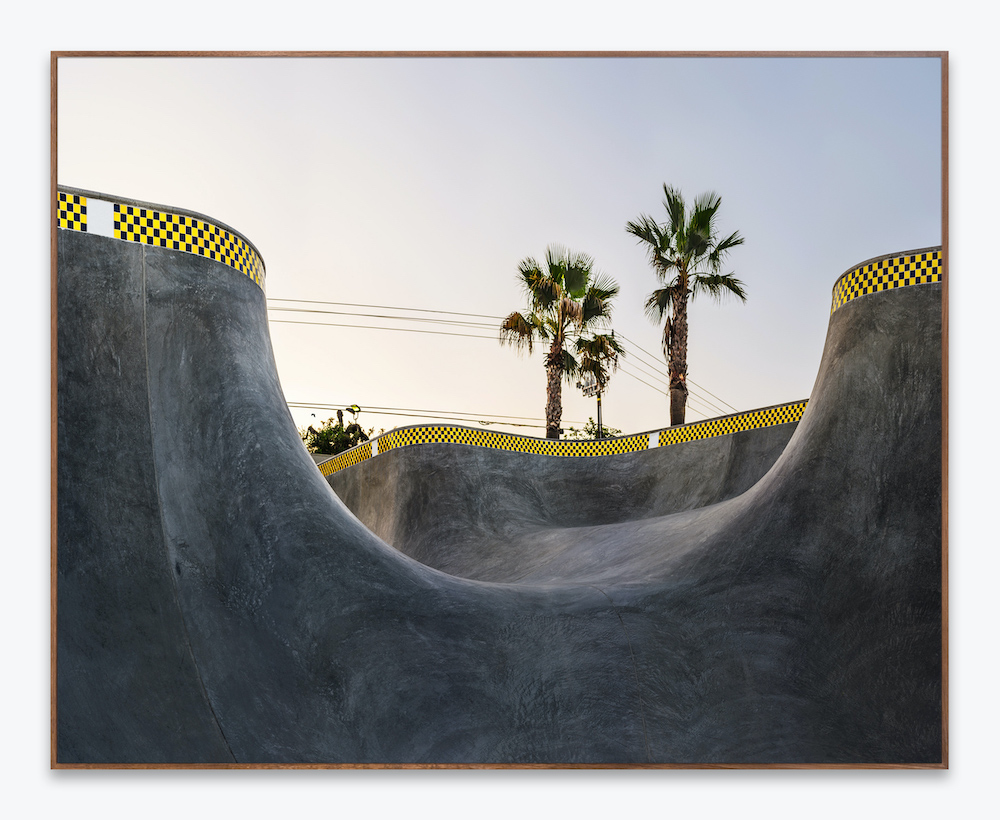CM: The other part of this exhibition (Empty Vessel – Amir Zaki, at the Frank M. Doyle Arts Pavilion, Orange Coast College) are photographs of ceramic vessels. Are they in fact broken?
AZ: You brought up the last body of work at ACME, which is important because that work provides context. In addition to the rocks, there were wooden sculptural pieces. Those were completely 3D constructed. The forms were made with an algorithm and a random process, almost as if you dropped a handkerchief in the sky and froze it in a formation. I then photographed wood veneers and applied that texture to create the forms. They were incredibly artificial and complicated.
This body of work started the same way. I had been photographing skate parks. In the middle of it, I started to think of the skate parks literally as carvings in the earth, into which they pour cement. It becomes a complicated vessel. With my interest in Eastern philosophy, I began thinking about the symbolism of the empty vessel as a container for potential energy or potential action. All these things were ruminating, and I was interested in ceramics. But what I really wanted to do was deal with the breaking of the vessel, the dysfunction. This goes back to taking a functional object, like a bowl, and making it dysfunctional. So I started making them digitally. I looked at software and algorithms to break them with random processes. But something about them looked fake, although I didn’t know what.
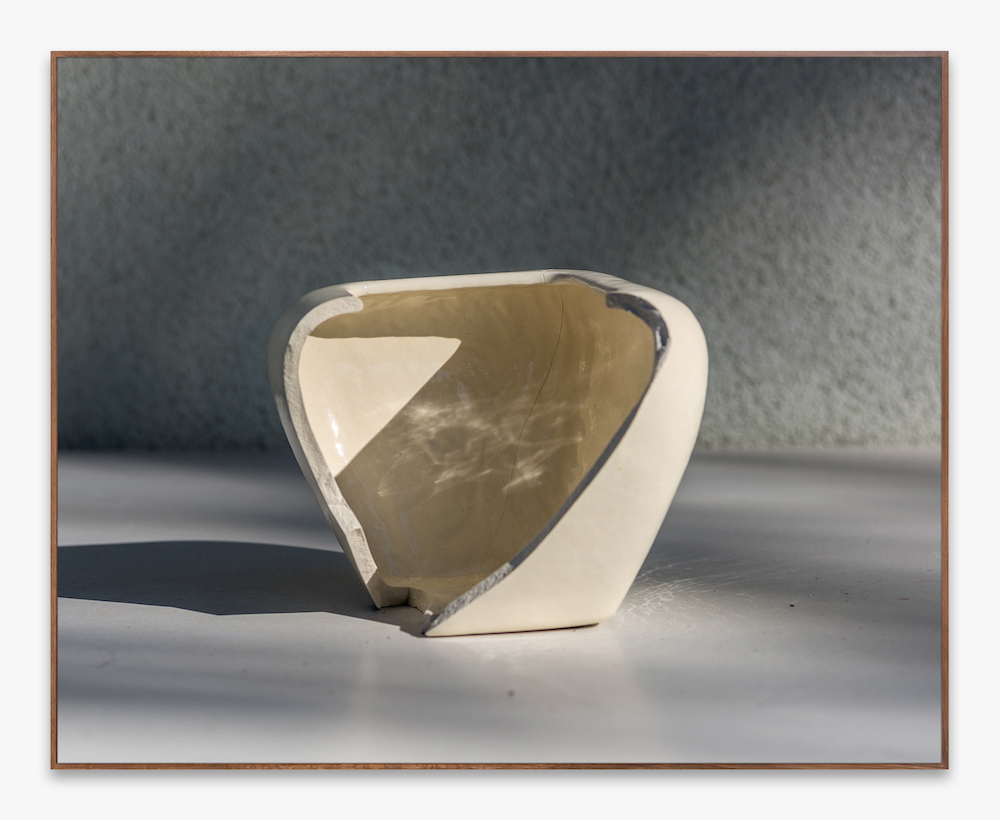
Broken Vessel 115, 2019
So I just bought something and broke it. I had been taking videos with my phone and posting them on Instagram, breaking things just to study them. Then I thought I didn’t need to work digitally, that this could be analog. So I started gluing them back together — breaking and gluing and photographing. Through this process, which was about five or six months, I had broken one and had extra shards lying around in my studio. While I was figuring out how to photograph them, I realized the shards were all I needed. And so I put one down and photographed it, and I thought, “Everything I need to talk about in this work is located in a broken piece.” It implies — in the way that you were talking about how the skate parks imply the social — this fragment implies the whole.
So then it was a matter of finding a way to photograph them that didn’t look like a studio. I constructed a space in my backyard, which during the late afternoon has sun coming through palm trees. I made a rule that it had to be windy so that there would be a kind of quality that’s constantly changing. They’re basically being photographed under natural light that is filtered through — here’s the California part — palm trees. So I didn’t have full control over the light or how they look.
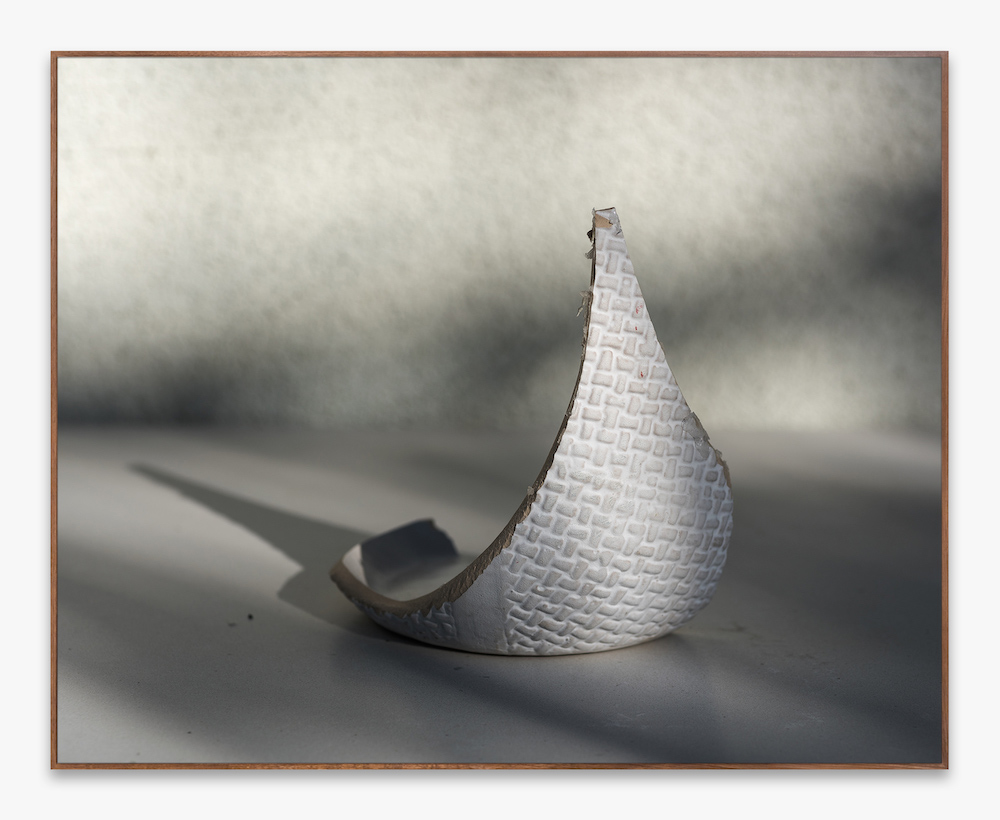
Broken Vessel 34, 2019
That’s how the project evolved. It’s a long way of saying they ended up being, of the work I’ve made in the last 20 years, the straightest photographs I’ve made. But they’re always seen in the context of people wondering. For me, that’s great. I’ve built a reputation of making people being suspicious — they walk in feeling suspicious. I’m happy to share the process. I’m not coy about it, but I do like that the veracity of photography is tumbling. People say, well that’s veneer, or that’s probably fake. Or he probably did that on Photoshop.
That’s how the ceramics became part of it. When I was putting them in the studio, it became natural for me to think about it as not being based in language but on how your body reacts to the fragility of a broken pottery shard versus the kind of permanence of these concrete forms and the cracks relating to each other.

Broken Vessel 92, 2019
There’s also a connection in that we refer to our bodies as vessels, so it poses metaphoric relationships to you as the viewer observing the broken vessel and the vessels you’re referring to as skate parks, as well. How do you think about the empty vessel in light of your interest in Eastern Philosophy?
I had to write a small piece for the book, and I ended with part of a chapter from the Tao te Ching, which is the most famous piece of Taoist literature. It is about the empty vessel, and to paraphrase, it says, we shape clay into bowls or into vessels, but it’s the emptiness that makes them useful. We build homes, but we cut out windows and doors, and it’s those cutouts that make them useful. It’s this poetic repetition. It refers to this idea that, first, you need both. When most people think of empty, they think that means that it’s nothing. Or they think that it loses its usefulness. But in fact, that emptiness is what makes it useful.
I see these as potential. The skate parks are potential for activity — skaters using them the way they were designed to be used. Certainly a bowl has that kind of potential. The thing about the broken ones is that I’m doing something a little bit more transgressive, where I’m prioritizing the photograph over the object. There is such a resurgence of ceramics, now, and this project allows me to be in dialogue with that. People experience much of that through images, which are basically studio images of ceramic objects floating in space. They’re certainly not functional. So I was thinking, there’s really no difference between them and thrift store-items that I just break and photograph in a really evocative way.
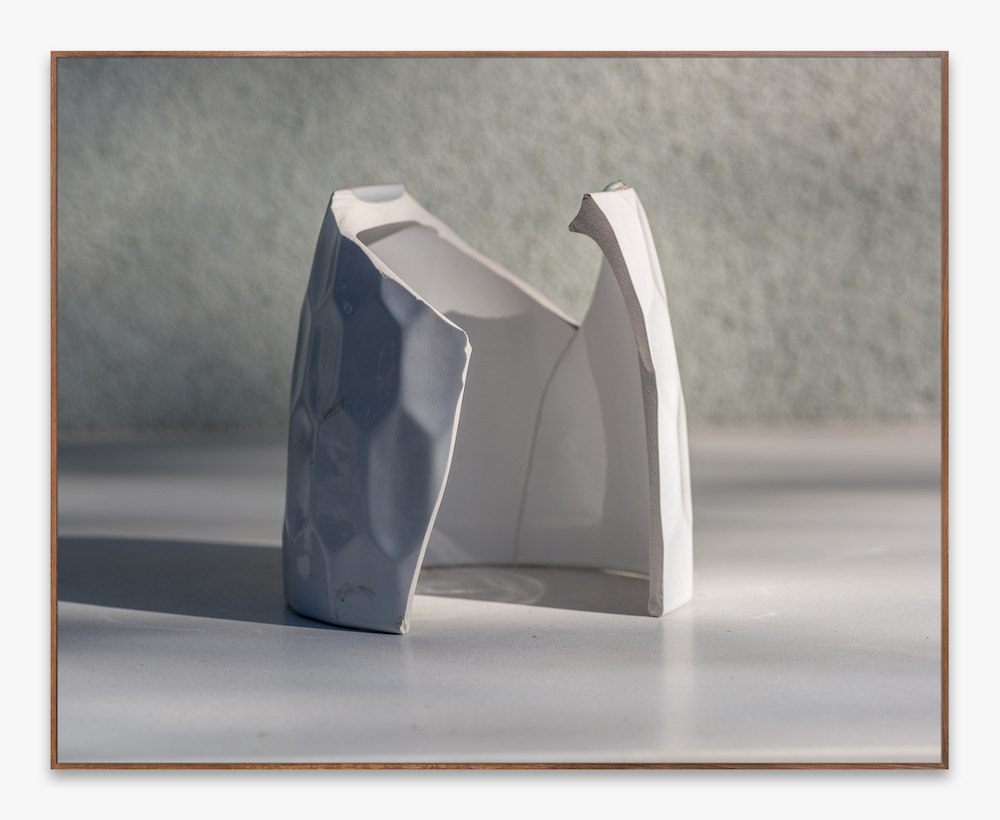
Broken Vessel 112, 2019
As a synthesis of the project, I started making limited edition boxes. Each box contains a poster, a concrete bowl, a print, and a poem. You discover the poem at the bottom of the box, only after you’ve pulled everything out. It was written by one of the very first female Zen masters, from the 1200s. It is an enlightenment poem, which describes the moment of her enlightenment: “This way and that way, I tried to keep the pail together, hoping the weak bamboo would never break. Suddenly the bottom fell out, no more water, no more moon in the water, emptiness in my hand.” For me, the poem relates to all this.
I made the 49 bowls in the dumbest way you can possibly imagine. I had a rock about the size of a head, and I made concrete balls, which I smashed onto the rock. The concrete sat like that, dried, and then I pulled it off and used that as a mold to make all 49 of the bowls.
Although they are all made from the same mold, they’re very different. I made no attempt to make one more beautiful than another or one better than another. It was about the idea of not discriminating.
All the titles come from a Zen poem, an important text that I’m interested in. I pulled words that are evocative and used those as titles. There’s no real relationship. I didn’t look at this one and say, you should be called independent. It was simply one after the other. The poster has images of each side of all 49 bowls. So it’s top and bottom. The idea is that anybody who wanted one of these would choose. They wouldn’t just get number 2 of the edition. They could choose based on some aesthetic, or because they really like the word sensation and the way that bowl looks. And so the one you get is circled and initialed by me on the poster. It’s kind of an artist’s book.
The print is literally a synthesis. It is a broken vessel and a skate park that are sitting within one another.
These are fragile. Some of them will probably break. The box is made of cardboard. It’s not archival or meant to be permanent. And so there are these ideas about impermanence and not discriminating between one thing or another, which are these Eastern ideas that I’m playing with. This is a little new for me, but this is a great opportunity in this context to show it.
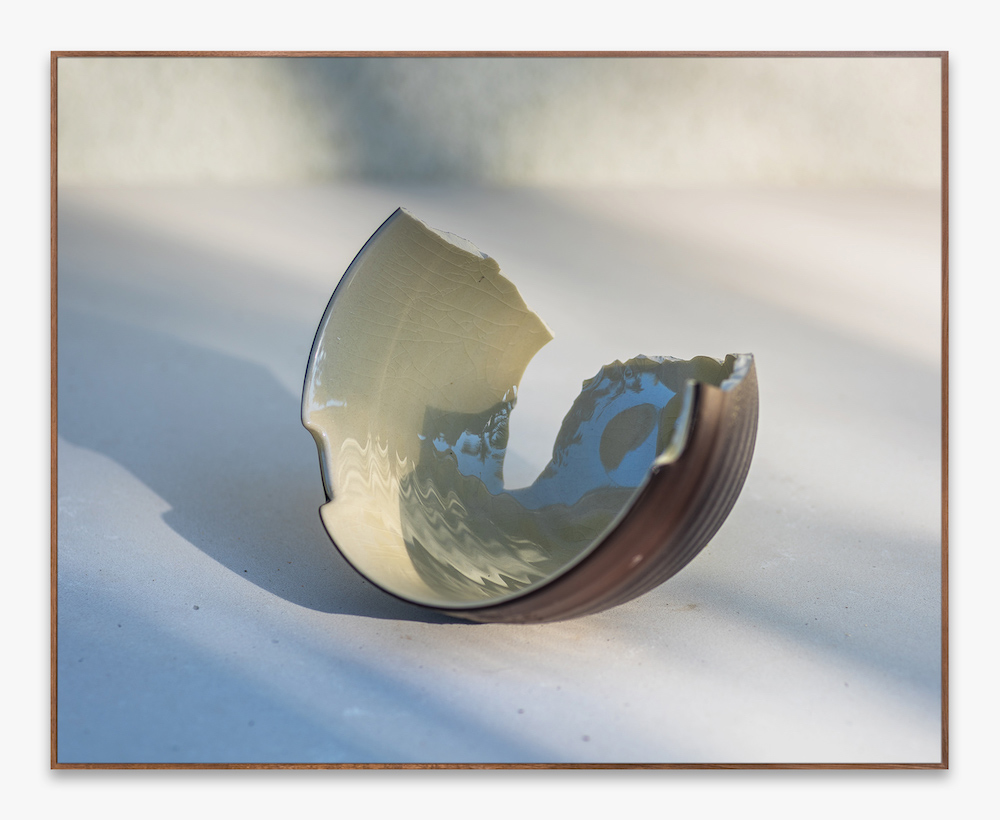
Broken Vessel 104, 2019
The title of the show is Empty Vessel, which you said speaks to the idea of potential. All of the photographs of the ceramics, they’re all in various stages of being broken. What is the reason for that?
I think what is latent in that, especially if you know the background of how they came to be, is that it brings up an ethics. So for instance, when I would buy these, I would go to Goodwill and look through racks and racks and choose ones that thought would make good broken pieces. I’d collect them in a basket, and the person at the checkout would ask, oh, do you want me to put these in paper for you? And I would say, no, don’t bother. And then there would be a conversation about how I was going to break them anyway. I was posting this process on Instagram, and I found it interesting how I tapped into people’s discomfort with the idea of destruction — that I’m intentionally destroying something that is perfectly functional. I think I knew that going into it. And I think that it fits with an ethos I have about all of my work, which has to do with questioning that value system. To me, I rescued things that were destined to sit in the Goodwill forever. They were already someone’s trash. And in this process, again, the ideas of destruction and creation — this is the Eastern part of it — those are not different. It’s Yin and Yang. So if you’re working with destruction, you’re working with creation too. So what I ended up making was a photograph of an object.
The aesthetic purpose of the thing just shifted from one thing to another. And the functional purpose shifted too. Now it’s an object of observation, not something you put water into. But it’s not destroyed.
And the values that are imbued with it have shifted too. But it was interesting because there was a clear delineation. People thought of it as a destructive act, violent too. I would show videos of it slow motion, things breaking, which was really fun for me. There’s a thought that there’s a kind of violence in that. I’m less interested in that because it doesn’t really fit with what I’m doing, but it is intended to maybe feel slightly uncomfortable.
And I like the idea of seeing that absence. That what we do when we see these is to imagine what they would be whole. We fill in the space. And I think that there’s a relationship to the skate parks, where people fill in these spaces with people or skateboarders. You look at a particular shape and you think what they might do in it. And I see those things as being in dialog with each other.
All images courtesy of the artist

